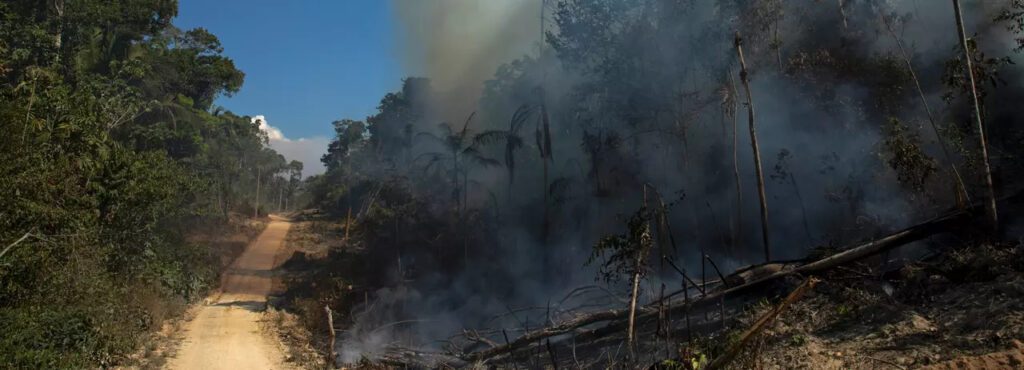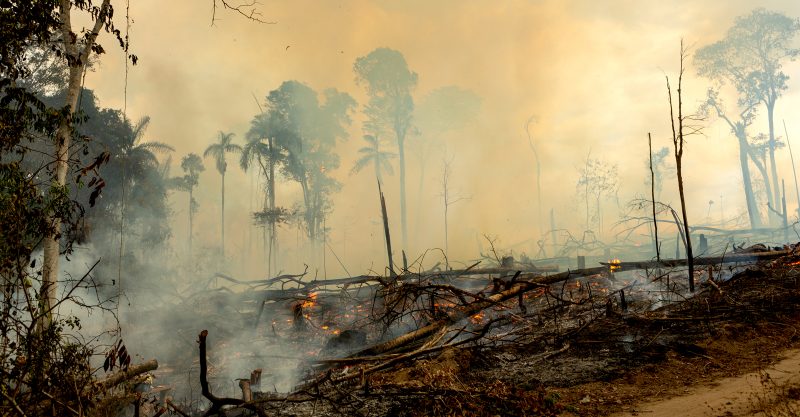‘Biggest Story in the World Right Now’: Humanity Has Flipped Amazon from Carbon Sink to Source
ENVIRONMENT, 26 Jul 2021
Jessica Corbett | Common Dreams - TRANSCEND Media Service
Recent research has elevated concerns about the Amazon putting more CO2 and other greenhouse gases into the atmosphere than it absorbs, but the new findings, published in the journal Nature, were presented as a “first” by scientists and climate reporters. They “show that the uncertain future is happening now.”

Even with a decree banning fires, flames and clouds of smoke were seen near the city of Novo Progresso, in southern Pará, Brazil, on August 15, 2020. (Photo: Ernesto Carriço/NurPhoto via Getty Images)
14 Jul 2021 – Following years of warnings and mounting fears among scientists, “terrifying” research revealed Wednesday that climate change and deforestation have turned parts of the Amazon basin, a crucial “sink,” into a source of planet-heating carbon dioxide.
Though recent research has elevated concerns about the Amazon putting more CO2 and other greenhouse gases into the atmosphere than it absorbs, the new findings, published in the journal Nature, were presented as a “first” by scientists and climate reporters.
From 2010 to 2018, researchers for the new study—led by Luciana Gatti of Brazil’s National Institute for Space Research—conducted “vertical profiling measurements” of carbon dioxide and monoxide a few miles above the tree canopy at four sites in Amazonia.
The researchers found that “Southeastern Amazonia, in particular, acts as a net carbon source” and “total carbon emissions are greater in eastern Amazonia than in the western part.” The former, they noted, has been “subjected to more deforestation, warming, and moisture stress” than the latter in recent decades.
https://twitter.com/elliemaeohagan/status/1415339421201805313?ref_src=twsrc%5Etfw%7Ctwcamp%5Etweetembed%7Ctwterm%5E1415339421201805313%7Ctwgr%5E%7Ctwcon%5Es1_&ref_url=https%3A%2F%2Fwww.commondreams.org%2Fnews%2F2021%2F07%2F14%2Fbiggest-story-world-right-now-humanity-has-flipped-amazon-carbon-sink-source
As The New York Times reported Wednesday:
In an accompanying article in Nature, Scott Denning, a professor in the department of atmospheric science at Colorado State University, wrote that the paper’s “atmospheric profiles show that the uncertain future is happening now.”
In an emailed response to questions, Dr. Denning praised the new study as the first real large-scale measurement—from various altitudes across thousands of kilometers and remote sectors—of the phenomenon, an advance beyond the traditional measurement at forest sites. The results show “that warming and deforestation in eastern Amazonia have reversed the carbon sink at regional scale and that the change is actually showing up in atmospheric CO2,” he wrote.
Gatti told The Guardian that “the first very bad news is that forest-burning produces around three times more CO2 than the forest absorbs. The second bad news is that the places where deforestation is 30% or more show carbon emissions 10 times higher than where deforestation is lower than 20%.”
According to the newspaper—which noted the role of emissions from deliberately set fires for beef and soy production as well as the global criticism that Brazilian President Jair Bolsonaro has faced for encouraging the soaring deforestation:
Fewer trees meant less rain and higher temperatures, making the dry season even worse for the remaining forest, she said: “We have a very negative loop that makes the forest more susceptible to uncontrolled fires.”
Much of the timber, beef, and soy from the Amazon is exported from Brazil. “We need a global agreement to save the Amazon,” Gatti said. European nations have said they will block an E.U. trade deal with Brazil and other countries unless Bolsonaro agrees to do more to tackle Amazonian destruction.
The study comes after a March analysis, published in the journal Frontiers in Forests and Global Change, that took into account not only CO2 but also methane, nitrous oxide, black carbon, biogenic volatile organic compounds, aerosols, evapotranspiration, and albedo.
The new findings also follow an April study, published in Nature Climate Change, that focused on Brazil, which is home to the majority of the incredibly biodiverse and threatened rainforest that spans nine countries.
Comparing that research to Wednesday’s, Denning said that “they’re complementary studies with radically different methods that come to very similar conclusions.”
“The Amazon rainforest is emitting a billion tonnes of carbon dioxide a year.” #FaceTheClimateEmergency #EcologicalBreakdown https://t.co/vmhHNbU3Gz
— Greta Thunberg (@GretaThunberg) July 14, 2021
The researchers from the April study, who relied on satellite monitoring, found that between 2010 and 2019, the Brazilian Amazon released 16.6 billion tonnes of carbon dioxide, while only taking in 13.9 billion tonnes—meaning that over a decade, it released nearly 20% more CO2 than it absorbed.
“We half-expected it, but it is the first time that we have figures showing that the Brazilian Amazon has flipped, and is now a net emitter,” said co-author Jean-Pierre Wigneron, a scientist at France’s National Institute for Agronomic Research (INRA), at the time. “We don’t know at what point the changeover could become irreversible.”
Agence France-Presse reported that in a statement about the study, INRA said that “Brazil saw a sharp decline in the application of environmental protection policies after the change of government in 2019,” referencing when Bolsonaro was sworn in as president.
“Imagine if we could prohibit fires in the Amazon—it could be a carbon sink,” Gatti said Wednesday, noting the negative impact of converting swaths of the rainforest last for agriculture. “But we are doing the opposite—we are accelerating climate change.”
________________________________________________
Jessica Corbett is a staff writer for Common Dreams.
Our work is licensed under Creative Commons (CC BY-NC-ND 3.0). Feel free to republish and share widely.
Tags: Amazonia, BRICS, Bolsonaro, Brazil, CO2, Carbon source, Cattle and Ranch Farmers, Climate Change, Corruption, Deforestation, Environment, Forest fires, Global warming, Greenpeace, Human Rights, Indigenous Rights, JBS, Latin America Caribbean, Meat Industry, Nature's Rights, Rain Forests, Resources, Violent conflict
DISCLAIMER: The statements, views and opinions expressed in pieces republished here are solely those of the authors and do not necessarily represent those of TMS. In accordance with title 17 U.S.C. section 107, this material is distributed without profit to those who have expressed a prior interest in receiving the included information for research and educational purposes. TMS has no affiliation whatsoever with the originator of this article nor is TMS endorsed or sponsored by the originator. “GO TO ORIGINAL” links are provided as a convenience to our readers and allow for verification of authenticity. However, as originating pages are often updated by their originating host sites, the versions posted may not match the versions our readers view when clicking the “GO TO ORIGINAL” links. This site contains copyrighted material the use of which has not always been specifically authorized by the copyright owner. We are making such material available in our efforts to advance understanding of environmental, political, human rights, economic, democracy, scientific, and social justice issues, etc. We believe this constitutes a ‘fair use’ of any such copyrighted material as provided for in section 107 of the US Copyright Law. In accordance with Title 17 U.S.C. Section 107, the material on this site is distributed without profit to those who have expressed a prior interest in receiving the included information for research and educational purposes. For more information go to: http://www.law.cornell.edu/uscode/17/107.shtml. If you wish to use copyrighted material from this site for purposes of your own that go beyond ‘fair use’, you must obtain permission from the copyright owner.

